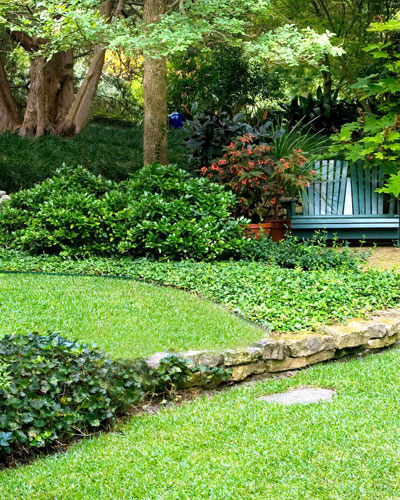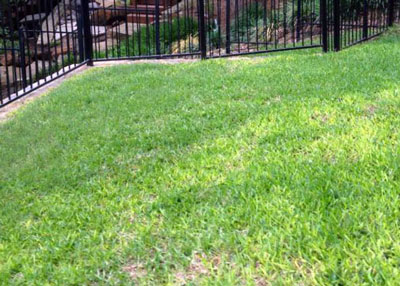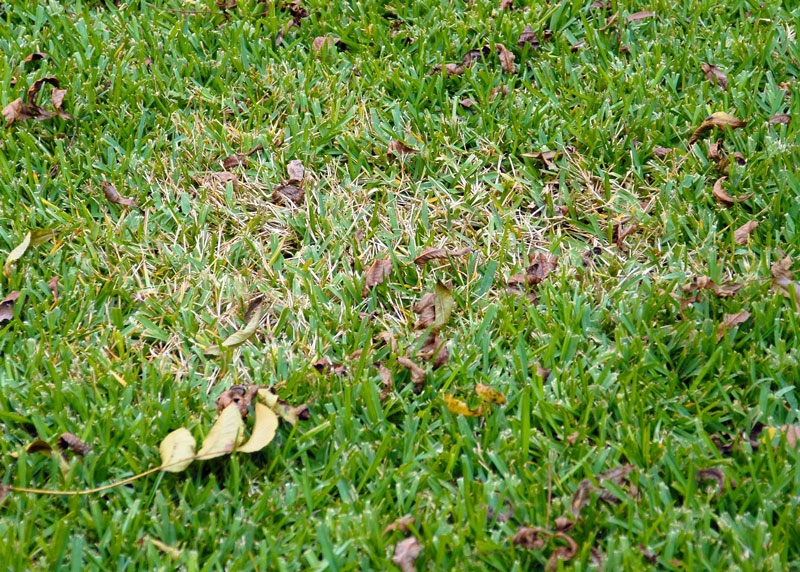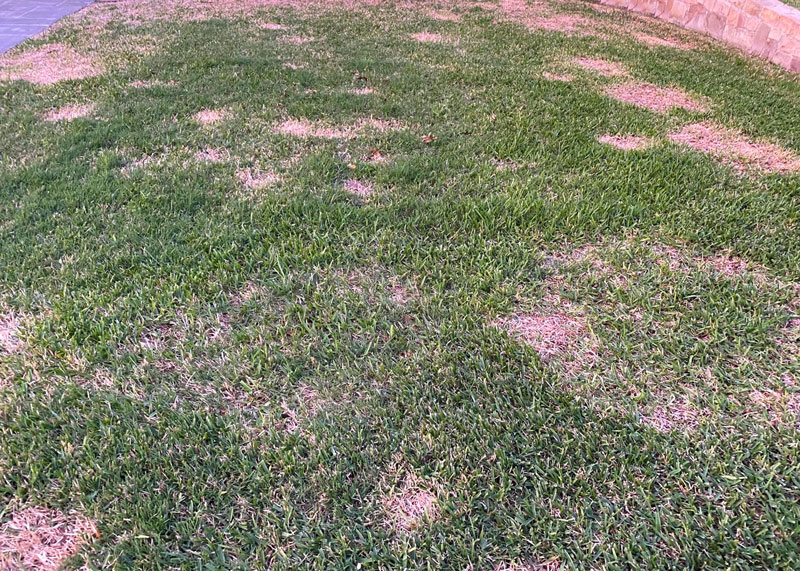St. Augustine Problem-Solving

We do not have “the perfect turfgrass.” So, before you throw St. Augustine under the bus, remember that all of our other grasses have their own issues, too.
I’m going to begin with a quick list of the positive reasons we might want to grow St. Augustine.
• It’s our most-shade tolerant lawngrass. In South Texas where it stays green all winter it can survive in only 3 or 4 hours of sunlight (or seemingly less). In North Texas where it goes dormant in winter it needs at least 5 or 6 hours of sunlight. But zoysias need 6 or 7 and bermuda needs 8.
• It’s the dominant grass. It will crowd out all other turfgrasses if given modest care.
• It’s the least likely grass to cause allergies from fungal spores it might be harboring. At the other end of the spectrum, bermuda gives many people fits while they’re mowing.
Identifying the cause of St. Augustine ills…
Here are the steps that I take when trying to help a caller to one of my radio programs or a reader who has written to one of the newspapers for which I write.
★ What specific part of a month did the problem first become visible? This is absolutely critical information because the various disease and insect problems are very seasonal. I’ll show you in a chronological outline later.
★ What are you seeing? Symptoms of the common St. Augustine problems are very similar. Their timings overlap, and they can be hard to describe accurately enough for consumers to identify with confidence. You can’t get by simply by saying, “The lawn looks dead.”
★ I’ll need to know if the problem is in small or large patches, and if so, how regularly they’re shaped (circles versus irregular “washes”).
★ Somewhere early in our chat I’m going to ask you to estimate how much sunlight the lawn is getting. I’m not going to accept the answer, “Enough.” I’ll want to know how many hours of good, direct sunlight it gets on a clear summer day.
In more than 50 years of helping Texas gardeners, this lack of light thing is the most common issue. I wish I had a dime for every time I ended up seeing St. Augustine in too much shade. Simply put, does the grass get thinner the closer you get to the trunk of the tree (or other source of the shade)?
★ I’ll want to know if whatever problem seems to affect primarily the blades, or if the runners and roots are also involved. That information will involve tugging on a few of the runners to see if they pull loose easily from the soil.
★ I may ask you to check for the presence of insects (chinch bugs or grub worms). I may ask if you have seen June beetles around lights in very large numbers.
★ And I’ll need to know if you have applied any kind of insecticide or fungicide recently. They could affect whether you will be able to find any of the things for which I’m asking you to search.
★ I may even ask you if you have used any fertilizer recently. Nitrogen applied in the summer stimulates development of gray leaf spot fungus.
★ I might even ask if you have applied any weedkiller to the turf. Some weedkillers are labeled only for use on other types of turfgrass or at other times of the year. This falls into the category of “Read and follow label directions carefully.”
So, those are the sorts of things I’ll be wanting to know, as will any Texas Certified Nursery Professional from whom you seek help.
Chronological order of St. Augustine problems…
Here are the most common problems folks face when growing St. Augustine turf. Since timing is one of the most critical parts of figuring out the type of problem we’re facing, I’ll list them in general chronological order starting in late winter and progressing through the calendar year.
WHITE GRUB WORMS
• Coming out of winter dormancy (northern part of St. Augustine range).

If the grass is brown and fails to green up, pull on it firmly. If it comes loose easily in large hunks, that’s probably damage of white grub worms. They’re 3/4-inch larvae of one of the smallish species of June beetles. The larvae have legs, they’re always C-shaped and they have brown heads.
The threshold of damage with white grub worms is 5-6 grub worms per square foot. Fewer than that and they are not a major threat. If you find them, apply a labeled turf insecticide in early June in South Texas and mid-June in North Texas. Water it in thoroughly. Grub worms are much less of a problem currently that they were several decades ago.
EXCESSIVE SHADE
• As grass starts to grow in spring’s warm weather.

If you notice that your turfgrass is retreating beneath your shade trees, it may be due to excessive shade. St. Augustine requires 3 to 4 hours of direct sunlight in South Texas and 5 to 6 hours in North Texas. If it doesn’t get quite that much its spreading growth will gradually slow down and die out as the trees grow larger.
This is a far more common problem than most people realize. If you have planted new sod before and watched it fade out over the first couple of months, that was probably due to the shade. Before you waste hundreds of dollars on more sod, do more homework. You might be better served with a shade-tolerant groundcover. Thinning the trees is often not a permanent solution.
TAKE ALL ROOT ROT (TARR)
• As grass greens up in early to mid-spring.

This is when the fungal disease known as take all root rot is most active. This disease appears as pale green or yellow “washes” across the lawn. There will be areas where the grass looks completely healthy and other areas where it is very pale.

When you pull on the runners they will offer little resistance. When you examine their roots, they will be dark and shortened due to the fungus. You should check for white grub worms, but don’t be surprised if you find few or none.
Take all root rot is a cool-season disease of mid- to late spring (March through May, depending on where you are in Texas). It is far more common in areas with alkaline soils (therefore, not as common in East Texas).

The control for TARR is the fungicide Azoxystrobin.
GRAY LEAF SPOT
• As summer’s hot weather gets started.

Gray leaf spot, as the name implies, results in diamond-shaped, BB-sized gray-brown spots on the blades and sometimes on the runners.

Affected lawns have yellowed areas similar to those of TARR, except the leaf spots will be very visible and the root systems will not be affected.
Gray leaf spot is accelerated by nitrogen. That’s why you shouldn’t fertilize St. Augustine from mid-June until early September if you have had a known problem with gray leaf spot in the past.
The fungicide Azoxystrobin is labeled for control of gray leaf spot, but laying off the nitrogen fertilizer is every bit as important.
Gray leaf spot is a warm-season disease of the summer.
CHINCH BUGS
• In hottest part of summer and in sunniest parts of the yard.

Chinch bugs will cause your St. Augustine to look like it needs to be watered. But watering won’t help. That’s when it’s time to get down on your hands and knees and search for the insects. They’re BB-sized, black with irregular white diamonds on their backs (wings).

Chinch bugs will always be in those hottest, sunniest parts of your lawn and they will return to the same spots summer after summer.
They will be at the interface between healthy turf and the browned lawngrass. Look for them to be moving about freely. If you find them apply a labeled insecticide and water moderately. One treatment may be all that you will need, but don’t put it off. They can quickly kill large parts of your lawn.
BROWN PATCH, ALSO KNOWN AS LARGE PATCH
• As first significant rainy, cold weather hits in mid-fall.

Brown patch is now, more and more, being called “large patch” by university turf experts and plant pathologists. It is most common in October and November, showing up first as round patches 18 to 30 inches. Yellowed blades pull loose easily from the runners with gentle tugs.


You’ll be able to see where the fungus has caused the blades to decay at the bases of their sheaths – where they attach to the runners. Within a few days the entire patch will turn brown with the blades withering.
The patches do not enlarge, but new patches will develop and often will meld together until big parts of the yard are impacted.

Brown patch does not affect the runners or roots, so the grass often greens back up again if there is enough warm weather before the first frost. It won’t kill the grass, but it does weaken it enough that extreme cold in the winter can do more damage than happens to the healthy grass.
Once again, the fungicide Azoxystrobin is labeled for control of brown patch disease.
Brown patch (large patch) is a cool-season fall disease.
WHITE GRUB WORMS, next generation
• As lawn begins to wrap up its growing season.
It’s unlikely that you will see damage of white grub worms in the fall, but it could happen in a year of a really bad infestation. If your lawn becomes weak even with good care, and if you can pull it loose easily from the soil because of roots that have been lost to the feeding done by the grubs, dig several test holes. If you find 5 or more grubs per square foot you might expect loss of parts of your lawn. However, the grubs will have completed most of their feeding by the early part of November. Application of insecticide at this late date will be of little benefit. Just mark your calendar to apply a labeled insecticide in early to mid-June the following summer.


